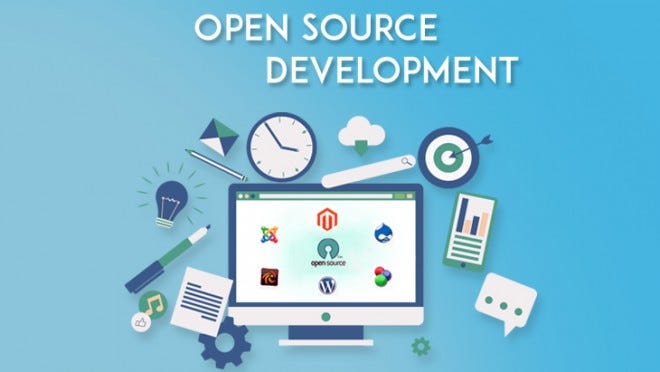Some facts about open source software
Developers have been familiar with open source software for a long time, but business owners still find such apps perplexing. We will tell you in what cases it is possible and necessary to use open source solutions.
Open source development features
Any developer can change the code of an open source solution and share it with others. As a rule, such projects are created by professionals and amateurs who want to develop an open source program in their spare time. Open source software can take years of work when thousands of programmers are gradually adding pieces of code to it.
The programming community carefully checks new lines of code, and developers include reliable and high-quality code in projects. If someone’s code fails while testing, it is not accepted.
A well-known example of an open source solution is the Linux operating system. It was released in 1991 under a GPL license. This means that it was free to install, use, modify, and distribute. As a result, the OS has a large community of developers who have enriched the program with powerful new features. Even its competitor, Microsoft, has contributed to its open source code.
Unique commercial software rarely does without open source solutions. Most programs (90%) are built using open source components. In 2020 alone, there were 1.5 trillion download requests for open source containers and libraries.
According to OSSRA, 98% of medical codebases, 97% of financial apps, and 92% of eCommerce systems are open source. As you can see, open source is a common practice in many industries.
As Jim Zemlin, Linux Foundation CEO, noted, open source has become an important part of the economy. Hundreds of thousands of open source components are located in production apps throughout the supply chain and support critical business processes.

Source: higresources.com.ng
“Open” is not synonymous with “free”
The idea of open source is that a developer downloads a program along with its source code, changes it, fixes bugs, and transfers it to other users. But the availability of source code alone does not define open source solutions. On the web, you can find The Open Source Definition, a document that determines the characteristics of open source software:
- such software can be distributed and sold without restrictions,
- the source code of a program should be easily accessible,
- the source code of a program can be changed or part of it can be used in other projects,
- the license must not harm other programs that come with it.
The first paragraph of the document says that open source solutions can be sold. In the world of programming, the development of many commercial web and mobile solutions is associated with open source.
For example, Red Hat developed the free GNU/Linux operating system and made a paid product based on it (RHEL). The commercial SaaS solution Docker Hub is in the Docker ecosystem. Any custom project can use an open source program. A good example is Chronicle Software, which develops the Chronicle family of free projects and fulfills systems development orders based on them.
Open source development can be applied even for individual software solutions for corporations. SMEs with their fewer resources can freely and cost-effectively use such solutions, adapting them to their needs.

Source: itsfoss.com
The impact of open source software on businesses
The fact that open source solutions are at the heart of 90% of apps says a lot. With open source, companies get the following benefits:
- Enhanced security
The first concern of business leaders is how reliable open source solutions are and whether they may become a weak link in a corporate system. Most commercial software is created by small teams on a tight schedule and with a limited budget. These issues affect the quality of code and the degree of security.
When developing commercial software, a customer commits themselves to a specific company. In this case, modifications, additions, and updates depend on the skills of programmers and their pace of work. If such collaboration is terminated, product support will end and the program may become vulnerable.
Open source solutions are available to all developers, so they are constantly updated and improved. World-class organizations (Linux Foundation, GitHub, Google, IBM) have already united their forces to create the OpenSSF project. Its goal is to improve the security of open source software. Participants report vulnerabilities and develop security tools.
There are other projects (Coverity, Synopsys) that allow constant monitoring of open source software security through automatic scanning. On the Coverity resource, you can check the desired open source package and find out if it has vulnerabilities and at what level the developers support the project. As a result, open source solutions often rival commercial software when it comes to security.
- Flexibility
When working on a commercial project, an IT company and a customer are bound by an agreement that may limit developers. It is more difficult for them to scale and update the program, these processes can take more time. Since the code is not publicly available, you cannot adapt the product to your business if changes occur. You will have to contact the solution developers.
An open source program does not limit users and can be easily scaled according to their requirements. In-house IT specialists can adapt the code to your company’s business processes.
- Better integration
When building custom business solutions, developers consider the fact that they will need to be integrated with an organization’s existing systems. Ready-made programs have to be modified to achieve such integration, which is not always easy.
With an open source solution, developers can change the code and integrate the program with the company’s software. Community programmers are constantly researching the platform’s source code and suggesting updates and new features. They can also offer the best integration solution and help troubleshoot system failures.
- Quality code
Programmers who strive to make a program better and share their knowledge work on open source.
- Financial benefit
Closed source programs are expensive and harder to change, although there is a way out — rewriting a corporate program.

Source: nxglabs.in
Disadvantages of open source solutions
Open source is not suitable for a project in the following situations:
- Incompatibility with an operating system or a device.
An open source solution may not be compatible with your system. In this case, you may need new hardware and drivers.
- Lack of official technical support.
When a customer has questions about using custom software, they contact the technical support service. Free software has no official support service. You can ask the community of developers for help; however, the company may have to pay for external support.
- The complexity and intricacy of products.
Open source solutions are not always clear and accessible to users, because they are created primarily by developers and for developers. Their interfaces can be confusing and affect the work with programs. Without marketers and UX/UI designers, developers do not always know how to create effective software.
Any company can use open source solutions when developing its products. Programs created with their help are flexible and functional.







